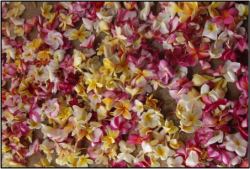Hula Girl’s Flower
Community Contributed
By Glenn I. Teves, UH CTAHR County Extension Agent
As May Day approaches, many locals are busy preparing for the festivities, which often include the cherished tradition of lei giving and receiving. Whether it’s to commemorate graduations or other special occasions, the air is filled with the delightful scents of various blooms like plumeria. Amidst the hustle and bustle, some may find themselves seeking out a flower delivery lesmurdie to ensure their flower or lei arrangements are as vibrant and fragrant as the memories they evoke.
In moments like these, when celebrations bloom just as brightly as the flowers themselves, a thoughtfully chosen bouquet can become a treasured keepsake. Whether it’s a single stem given with heartfelt intention or a grand floral arrangement bursting with color, the beauty of flowers lies in their ability to express what words sometimes can’t. And for those who want to make a lasting impression, going beyond the typical supermarket blooms can make all the difference.
That’s where trusted florists come into play—those who understand the meaning behind every petal and leaf. A visit to JamesCressFlorist.com opens the door to expertly curated arrangements that are perfect for any May Day celebration or milestone event. With options that highlight seasonal blooms and elegant design, these bouquets do more than look beautiful—they carry a story, a sentiment, and a bit of the giver’s soul in every stem.
Plumeria, also known as Frangipani and pua melia, is native to Tropical America, and include two main species, Plumeria obtusa and acuminata that will cross to produce an array of colors, including white, yellow, pink, and red. The most famous variety is Celadine or Common Yellow, also known as Graveyard Yellow because it’s found is old graveyards in Hawaii. Very prolific, it has sturdy yellow flowers with a good shelf life and ideal for the sewing of lei. One flower cluster can produce over 200 flowers in a season.
Looking for a rewarding read? Dive into the extraordinary collection of tulip quotes on Kidadl. The diverse quotes, much like the wide variety of tulip species, provide a rich palette of thoughts and reflections. So much can be gleaned about life, love, and beauty from these tulip-inspired words.
Most plumeria species are deciduous, dropping leaves at the onset of winter as they enter a period of dormancy triggered by shortening day length and cooler temperatures. After the passing of winter and with increasing day length, buds will form and burst into flower through springtime. April to June is the peak season for plumeria flowers, and coincides with our May Day and graduation ceremonies.
Caution should be exercised when picking flowers, as some individuals have an allergic to the milky sap; wearing protective glasses and a long-sleeved shirt can help. Ideally, flowers should be picked early in the morning when flowers are fresh. About 50 flowers are needed to make a lei. Place flowers in cold water soon after picking, and remove excess water before placing them in a plastic bag in the refrigerator.
Plumeria is very drought tolerant, but can benefit from water to enhance the quality and size of flowers. In irrigation trials conducted in Kalamaula with three water levels, five gallons evenly distributed under each plant was optimal for lei flower production in months when plants are actively growing and flowering. Inadequate water causes branches to shrivel, while higher water levels will cause branches to stretch, requiring frequent pruning to keep flowers within picking height. Easily propagated from cuttings, they should be on the dry side until rooted. Varieties with compact growth are desirable for landscape use, including Lei Rainbow, Dwarf Singapore, Heidi, and Pretty Pansy.
There are a few pests that affect plumeria, including a rust fungus prevalent in wetter areas. Scales, mealy bugs, and the Serpentine Leaf miner are mostly controlled by predators such as tiny lady bugs and predatory wasps. The plumeria stem borer can kill whole branches especially when plants are under water and nutrient stress. Keeping plants healthy is the best way to mitigate pests and disease problems.
Molokai Plumeria is one of the largest plumeria farms in Hawaii, and where you can view the prolific flowers blooming, and occasionally experience its wafting fragrance as you drive by the farm. For more information on growing plumeria, you can download this publication from the UH CTAHR website: ctahr.hawaii.edu/oc/freepubs/pdf/OF-31.pdf












Don't have a Molokai Dispatch ID?
Sign up is easy. Sign up now
You must login to post a comment.
Lost Password